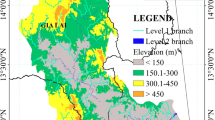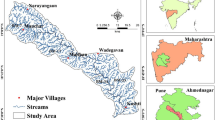Abstract
The analytic hierarchy process (AHP) in combination with geographic information system (GIS) provides an effective means for disaster monitoring. In the present study, GIS was used for the spatial analysis of drought for the Puruliya district, West Bengal, India. Fourteen parameters, such as annual rainfall, monthly rainfall, maximum temperature, monthly temperature, maximum evapotranspiration, monthly evapotranspiration, relative humidity, soil texture, landuse/landcover, slope, groundwater, cultivators, agricultural labourers and population were chosen and thematic maps for each parameter were developed. AHP was adopted to develop pairwise comparison matrices and to calculate the weightage factors of each parameter. Fourteen thematic maps were analysed, integrated and finally drought severity map was generated using GIS. The results showed that 70 % of the total area of Puruliya district is under severe drought affecting about 14 blocks. The output map thus obtained will provide information on severity of drought vulnerability which has practical relevance to agricultural importance and help in combating drought.






Similar content being viewed by others
References
Ahamed TRN, Rao KG, Murthy JSR (2000) GIS-based fuzzy membership model for crop-land suitability analysis. Agric Syst 63(2):75–95
Basu M, Hoshino S, Hashimoto S (2015) Many issues, limited responses: coping with water insecurity in rural India. Water Resour Rural Dev 5:47–63
Chen YR, Yeh CH, Yu B (2011) Integrated application of the analytic hierarchy process and the geographic information system for flood risk assessment and flood plain management in Taiwan. Nat Hazards 59(3):1261–1276
Chopra P (2006) Drought risk assessment using remote sensing and GIS: a case study of Gujarat. Thesis (ms), International Institute for Geo-information Science and Earth Observation, The Netherlands
Dalezios NR, Blanta A, Spyropoulos NV, Tarquis AM (2014) Risk identification of agricultural drought for sustainable agroecosystems. Nat Hazards Earth Syst Sci 14(9):2435–2448
Demir G, Aytekin M, Akgun A, Ikizler S, Tatar O (2013) A comparison of landslide susceptibility mapping of the eastern part of the North Anatolian Fault Zone (Turkey) by likelihood-frequency ratio and analytic hierarchy process methods. Nat Hazards 65(3):1481–1506
Dutta D, Kundu A, Patel NR (2013) Predicting agricultural drought in eastern Rajasthan of India using NDVI and standardized precipitation index. Geocarto Int 28(3):192–209
Eastman JR, Weigen J, Kyem PAK, Toledano J (1995) Raster procedure for multi-criteria/multi-objective decisions. Photogramm Eng Remote Sens 61(5):539–547
FAI (2012–13) Fertiliser statistics. The Fertiliser Association of India, New Delhi
Feizizadeh B, Blaschke T (2013) GIS-multicriteria decision analysis for landslide susceptibility mapping: comparing three methods for the Urmia lake basin, Iran. Nat Hazards 65(3):2105–2128
Gouveia C, Trigo RM, DaCamara CC (2009) Drought and vegetation stress monitoring in Portugal using satellite data. Nat Hazards Earth Syst Sci 9(1):185–195
GoWB (2012a) West Bengal State Action Plan on Climate Change (WB SAPCC). Government of West Bengal, India
GoWB (2012b) District Human Development Report, Human Development Coordination and Research Centre (HDRCC). Development and Planning Department, Government of West Bengal, India
Gu Y, Brown JF, Verdin JP, Wardlow B (2007) A five-year analysis of MODIS NDVI and NDWI for grassland drought assessment over the central Great Plains of the United States. Geophys Res Lett 34, L06407. doi:10.1029/2006GL029127
Hasekiogullari G, Ercanoglu M (2012) A new approach to use AHP in landslide susceptibility mapping: a case study at Yenice (Karabuk, NW Turkey). Nat Hazards 63(2):1157–1179
Joerin F, Theriault M, Musy A (2001) Using GIS and outranking multicriteria analysis for land-use suitability assessment. Int J Geogr Inf Sci 15(2):153–174
Legesse G, Suryabhagavan K (2014) Remote sensing and GIS based agricultural drought assessment in East Shewa Zone, Ethiopia. Trop Ecol 55(3):349–363
Malczewski J (1999) GIS and multicriteria decision analysis. Wiley, New York
Malczewski J (2006) GIS based multicriteria decision analysis: a survey of the literature. Int J Geogr Inf Sci 20(7):703–726
Muthumanickam D, Kannan P, Kumaraperumal R, Natarajan S, Sivasamy R, Poongodi C (2011) Drought assessment and monitoring through remote sensing and GIS in western tracts of Tamil Nadu, India. Int J Remote Sens 32(18):5157–5176
PACS (2008) Drought in India: challenges and initiatives. www.empowerpoor.org
Palchaudhuri M, Biswas S (2013) Analysis of meteorological drought using standardized precipitation index—a case study of Puruliya district, West Bengal. Int J Environ Chem Ecol Geol Geophys Eng 7(3):119–126
Pandey S, Pandey AC, Nathawat MS, Kumar M, Mahanti NC (2012) Drought hazard assessment using geoinformatics over parts of Chotanagpur plateau region, Jharkhand, India. Nat Hazards 63(2):279–303
Patel NR, Yadav K (2015) Monitoring spatio-temporal pattern of drought stress using integrated drought index over Bundelkhand region, India. Nat Hazards 77(2):663–677
Pereira JMC, Duckstein L (1993) A multiple criteria decision-making approach to GIS-based land suitability evaluation. Int J Geogr Inf Syst 7(5):407–424
Prakash PHS, Garg PK, Ghosh SK (2006) GIS based modeling for drought assessment. In: 26th Annual ESRI international user conference
Prathumchai K, Honda K (2001) Drought risk evaluation using remote sensing and GIS: a case study in Lop Buri Province. In: 22nd Asian conference on remote sensing
Rojas O, Vrieling A, Rembold F (2011) Assessing drought probability for agricultural areas in Africa with coarse resolution remote sensing imagery. Remote Sens Environ 115(2):343–352
Saaty TL (1977) A scaling method for priorities in hierarchical structures. J Math Psychol 15(3):234–281
Saaty TL (1990) How to make a decision: the analytic hierarchy process. Eur J Oper Res 48(1):9–26
Saaty TL (2008) Decision making with the analytic hierarchy process. Int J Serv Sci 1:83–98
Sadeghravesh MH, Khosravi H, Ghasemian S (2015) Application of fuzzy analytical hierarchy process for assessment of combating-desertification alternatives in central Iran. Nat Hazards 75(1):653–667
SAFE (2011) Community-ecosystem approach for adaptive watershed management in drought-prone tribal areas of West Bengal. www.resourceaward.org
Shamsipour AA, Reza PZ, Panah SKA, Azizi G (2011) Analysis of drought events for the semi-arid central plains of Iran with satellite and meteorological based indicators. Int J Remote Sens 32(24):9559–9569
Shang J, Sueyoshi T (1995) A unified framework for the selection of a flexible manufacturing system. Eur J Oper Res 85(2):297–315
Stefanidis S, Stathis D (2013) Assessment of flood hazard based on natural and anthropogenic factors using analytic hierarchy process (AHP). Nat Hazards 68(2):569–585
Store R, Jokimaki J (2003) A GIS-based multi-scale approach to habitat suitability modeling. Ecol Model 169(1):1–15
Sun Z, Zhang J, Zhang Q, Hu Y, Yan D, Wang C (2014) Integrated risk zoning of drought and waterlogging disasters based on fuzzy comprehensive evaluation in Anhui Province, China. Nat Hazards 71(3):1639–1657
Vasiliades L, Loukas A, Liberis N (2011) A water balance derived drought index for Pinios River Basin, Greece. Water Resour Manag 25(4):1087–1101
WMO (1999) Comprehensive risk assessment for natural hazards. World Meteorological Organisation (WMO)/TD No. 955
Ying X, Zeng GM, Chen GQ, Tang L, Wang KL, Huang DY (2007) Combining AHP with GIS in synthetic evaluation of eco-environment quality—a case study of Hunan Province, China. Ecol Model 209(24):97–109
Acknowledgments
The authors would like to thank all the organisations for providing the required data for the study as mentioned in the paper and also thankful to Council of Scientific and Industrial Research (CSIR), India, for providing financial support in the form of fellowship.
Author information
Authors and Affiliations
Corresponding author
Rights and permissions
About this article
Cite this article
Palchaudhuri, M., Biswas, S. Application of AHP with GIS in drought risk assessment for Puruliya district, India. Nat Hazards 84, 1905–1920 (2016). https://doi.org/10.1007/s11069-016-2526-3
Received:
Accepted:
Published:
Issue Date:
DOI: https://doi.org/10.1007/s11069-016-2526-3




